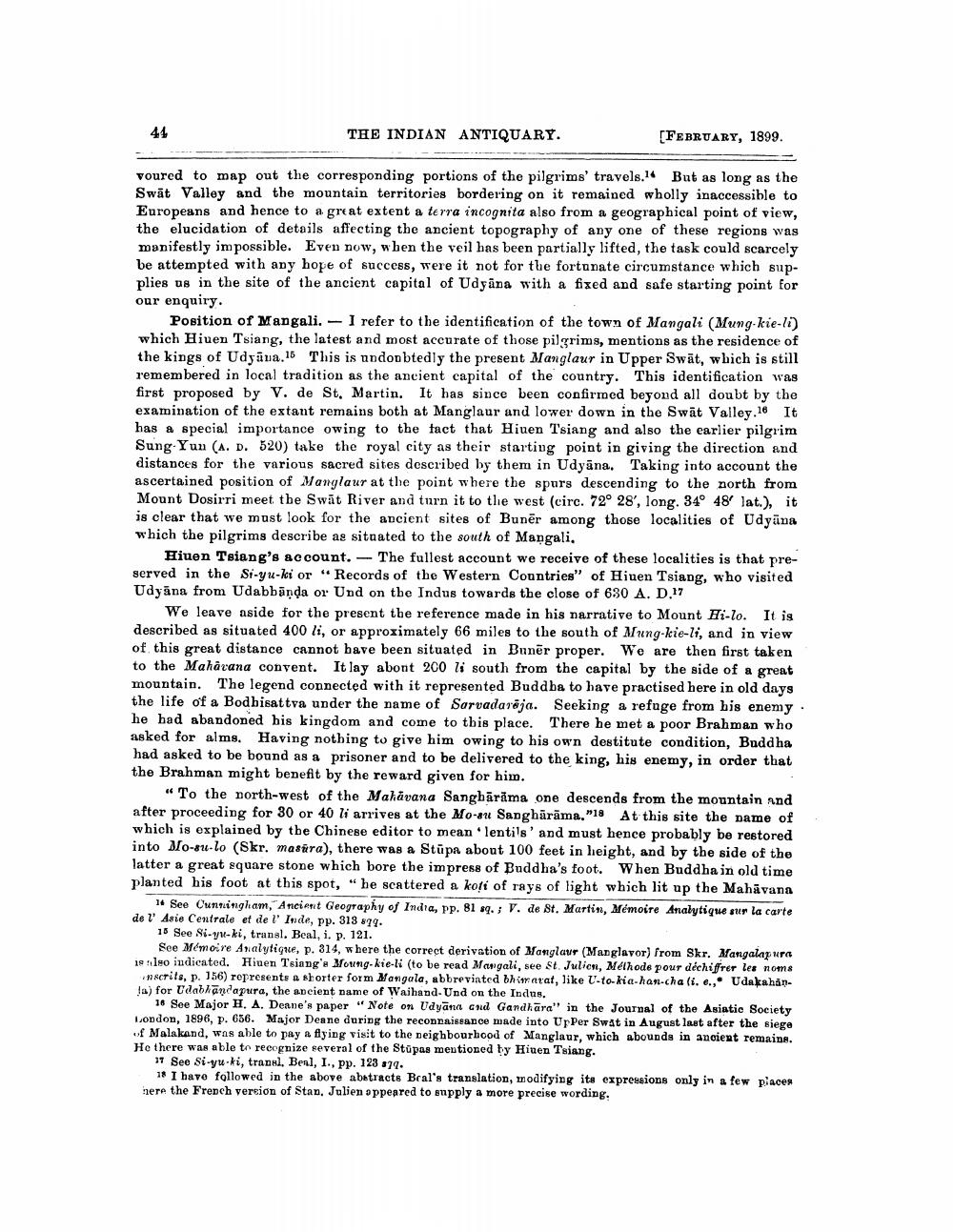________________
44
THE INDIAN ANTIQUARY.
[FEBRUARY, 1899.
voured to map out the corresponding portions of the pilgrims' travels. But as long as the Swat Valley and the mountain territories bordering on it remained wholly inaccessible to Europeans and hence to a great extent a terra incognita also from a geographical point of view, the elucidation of details affecting the ancient topography of any one of these regions was manifestly impossible. Even now, when the veil has been partially lifted, the task could scarcely be attempted with any hope of success, were it not for the fortunate circumstance which supplies us in the site of the ancient capital of Udyana with a fixed and safe starting point for our enquiry.
Position of Mangali. I refer to the identification of the town of Mangali (Mung-kie-li) which Hiuen Tsiang, the latest and most accurate of those pilgrims, mentions as the residence of the kings of Udyaua.15 This is undoubtedly the present Manglaur in Upper Swat, which is still remembered in local tradition as the ancient capital of the country. This identification was first proposed by V. de St. Martin. It has since been confirmed beyond all doubt by the examination of the extant remains both at Manglaur and lower down in the Swat Valley,16 It has a special importance owing to the fact that Hiuen Tsiang and also the earlier pilgrim Sung-Yun (A. D. 520) take the royal city as their starting point in giving the direction and distances for the various sacred sites described by them in Udyana. Taking into account the ascertained position of Manglaur at the point where the spurs descending to the north from Mount Dosirri meet the Swat River and turn it to the west (circ. 72° 28', long. 34° 48′ lat.), it is clear that we must look for the ancient sites of Buner among those localities of Udyana which the pilgrims describe as situated to the south of Mangali,
Hiuen Tsiang's account. The fullest account we receive of these localities is that preserved in the Si-yu-ki or "Records of the Western Countries" of Hiuen Tsiang, who visited Udyana from Udabbanda or Und on the Indus towards the close of 630 A. D.17
We leave aside for the present the reference made in his narrative to Mount Hi-lo. It is described as situated 400 li, or approximately 66 miles to the south of Mung-kie-li, and in view of this great distance cannot have been situated in Buner proper. We are then first taken to the Mahavana convent. It lay abont 200 li south from the capital by the side of a great mountain. The legend connected with it represented Buddha to have practised here in old days the life of a Bodhisattva under the name of Sarvadarēja. Seeking a refuge from his enemy. he had abandoned his kingdom and come to this place. There he met a poor Brahman who asked for alms. Having nothing to give him owing to his own destitute condition, Buddha had asked to be bound as a prisoner and to be delivered to the king, his enemy, in order that the Brahman might benefit by the reward given for him.
"To the north-west of the Mahavana Sanghārama one descends from the mountain and after proceeding for 30 or 40 li arrives at the Mo-au Sanghārama."18 At this site the name of which is explained by the Chinese editor to mean 'lenti's' and must hence probably be restored into Mo-su-lo (Skr. masura), there was a Stupa about 100 feet in height, and by the side of the latter a great square stone which bore the impress of Buddha's foot. When Buddha in old time planted his foot at this spot, "he scattered a koti of rays of light which lit up the Mahāvana
14 See Cunningham, Ancient Geography of India, pp. 81 sq.; V. de St. Martin, Mémoire Analytique sur la carte de l'Asie Centrale et de l' Inde, pp. 313 sqq.
15 See Si-yu-ki, transl. Beal, i. p. 121.
See Mémoire Analytique, p. 314, where the correct derivation of Manglaur (Manglavor) from Skr. Mangalapura 18lso indicated. Hiuen Tsiang'a Moung-kie-li (to be read Mangali, see St. Julien, Méthode pour déchiffrer les noms inscrits, p. 156) represents a shorter form Mangala, abbreviated bhimarat, like U-to-kia-han-cha (i. e., Udakahana) for Udabhandapura, the ancient name of Waihand- Und on the Indus.
16 See Major H. A. Deane's paper "Note on Udyana and Gandhara" in the Journal of the Asiatic Society London, 1896, p. 656. Major Deane during the reconnaissance made into UpPer Swat in August last after the siege of Malakand, was able to pay a flying visit to the neighbourhood of Manglaur, which abounds in ancient remains. He there was able to recognize several of the Stupas mentioned by Hiuen Tsiang.
17 See Si-yu-ki, transl. Beal, I., pp. 123 $77.
18 I have followed in the above abstracts Bral's translation, modifying its expressions only in a few places here the French version of Stan, Julien appeared to supply a more precise wording.




